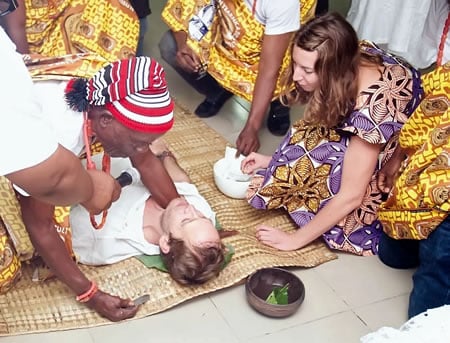
A cultural organisation, EyisiEbuluo Foundation and the British Council re-enact the dying practice of having traditional facial marks at a ceremony in the Federal Capital Territory. TEMITAYO AMOGUNLA reports
THE sound of ringing bells blends with the thrumming of drums. One man is beating two slit wooden drums and another jingling the rattles (oyo) in unison. Ufie music welcomes the Nwadioka, traditional tattooist to the compound of the Nwa-ichi, the man to be tattooed. Known beyond Neni, Ufie—the music produced by the instruments—is an important music with traditional significance. It is played at prominent ceremonial events like festivals, chieftaincy, as well as during Igbu-Ichi. As the compere takes the microphone, it stops.
ALSO READ: Ambode: Verdict from the street
“Dioka!” shouted the Master of the Ceremony, IkemMgbemena.
“Abunya!” responded members of the audience who were familiar with the call.
It is a common salutation among the Umudioka people of Neni, Anambra state. It is also an expression of patriotism, of loyalty to their community. After the Nigerian National Anthem was sung; it was followed by the Umudioka anthem which was sung solely in Igbo; what did you expect?
At the edge of the proscenium-style arrangement of the venue were older men garbed in native Igbo attire—all important men in the Umudioka community with a firm knowledge of IgbuIchi. One of them is Chief OdidikaChidolue, the last man with IgbuIchi on his face. And beside them is a picture of different marked men in Neni, all dead, except him. Igbu Ichi, is not only traditional facial marks drawn across the face from the forehead to the cheeks, it is more. Igbu-Ichi is a traditional craft with an entire cultural system around it is gradually going extinct. Done by Nwadiokas, itinerant traditional herbalists cum artists who learned the craft through years of apprenticeship. Also built around this art is a social welfare system, a dispute resolution system as well as a legal system that ensures balance in the communal society.
In the middle of the space is a mat propped up around the head region; beside it, is a small calabash with herbs and on the mat, is a plantain leaf.
Before the actual Igbu-Ichi ceremony, there was kola nut breaking session which was carried out in Igbo language because “the kola only understands the language of the breaker,” explains the compere. The kola nut is symbolic in Igboland. It is present at every occasion. At this occasion, it was used to offer prayers and also to recognise everyone from different nations and ethnic groups present there. After the kola breaking session, garden eggs were shared among the audience. This points to the sense of communality among the Igbos. Even though the kola was shared according to age, everyone partook of the feast.
After the kola breaking session, the Igbu-Ichi ceremony officially begins. The Nwa-Ichi, was brought in on the back of anNwa-Nso. Once brought in, the proceedings started with songs. The Nwa-Ichi’s legs and arms were held by the Nwa-Nso, as it would have been when the real marks were made. As the “cutting” is being simulated, the Nwa-Ichi’s sister kneels beside him and feeds him with dried fish. Once the process is done, he is carried on the back, out the same way he was brought. After this is done, it is assumed that the Nwa-Ichi has now become a man and as all male members of the community can now take a traditional title.
“It is important to have this re-enactment because we believe that more people across the world need to know about Igbu-Ichi and the culture around it,” said ChiedozieUdeze of EyisiEbuluo Foundation, the cultural organisation behind the programme.
Two men went through the process on August 25, 2018 at the British Council: Spanish, Juan Payo, and Norwegian, Rey Brhre. While the marking was simulated, and not actually done, their partners fed them with dry fish. For Payo, the experience was thrilling as it offered him an experiential knowledge of the culture of traditional marking among Umudioka people.
“It makes me feel welcome, like a part of them,” he said that he still needs to find out whether it makes him Igbo.
After the ceremony was done, the men were donned in native Igbo attire: a stripped red cap and a wrapper with text related to Umudioka Community printed on it. They also took on Igbo names; Payo became known as OgbuEzi-Oha which means “to have marks to show” while Brhre became “OgbuNgwaNgwa” which means “do the marks fast fast.”
At the end of the ceremony, abacha-ichi, a special vegetable-based meal was served to the guests present while music played, even as some attendees danced to the playing music. Beyond the art form itself, the re-enactment brought to life that sense of communality, where everyone, young and old, in a traditional African community had a role to play for the community to thrive. While the tradition is endangered, the event showed that it is still alive and will remain so in the hearts of all those present. The question then is: will it continue to live, to find expression in these hearts? In what forms will it be manifest in the future? Only the future can tell.





